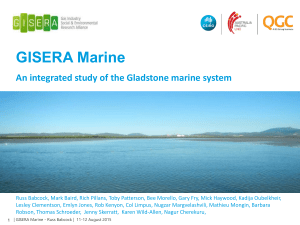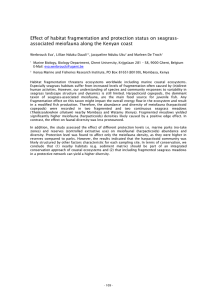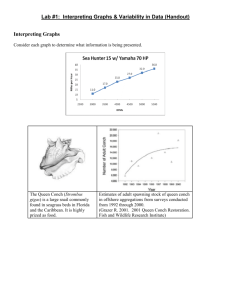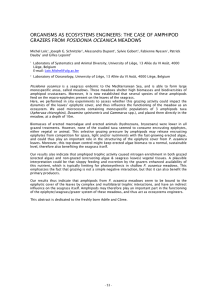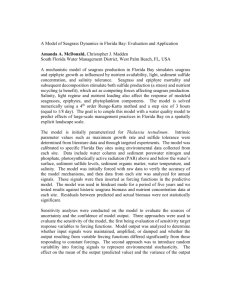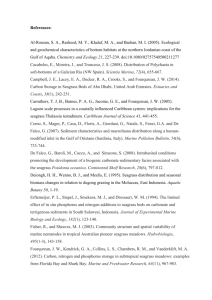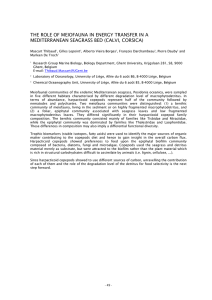USING A GIS MODEL BUILDER FOR OBJECT-BASED IMAGE CLASSIFICATION OF SEAGRASS MEADOWS RC
advertisement
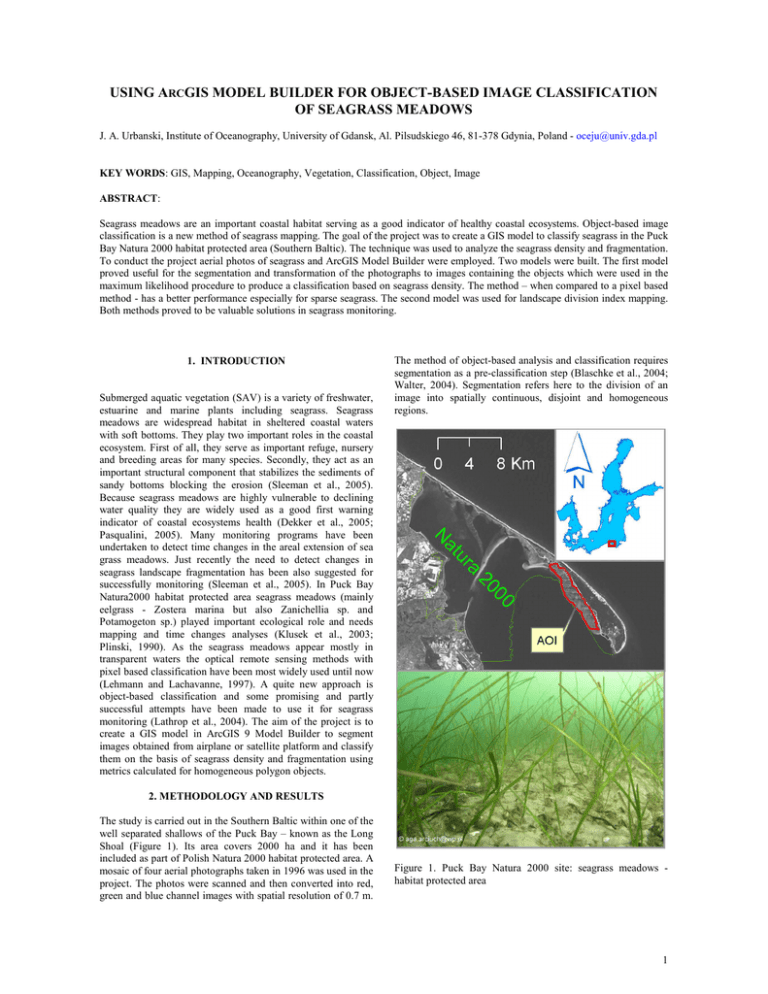
USING ARCGIS MODEL BUILDER FOR OBJECT-BASED IMAGE CLASSIFICATION OF SEAGRASS MEADOWS J. A. Urbanski, Institute of Oceanography, University of Gdansk, Al. Pilsudskiego 46, 81-378 Gdynia, Poland - oceju@univ.gda.pl KEY WORDS: GIS, Mapping, Oceanography, Vegetation, Classification, Object, Image ABSTRACT: Seagrass meadows are an important coastal habitat serving as a good indicator of healthy coastal ecosystems. Object-based image classification is a new method of seagrass mapping. The goal of the project was to create a GIS model to classify seagrass in the Puck Bay Natura 2000 habitat protected area (Southern Baltic). The technique was used to analyze the seagrass density and fragmentation. To conduct the project aerial photos of seagrass and ArcGIS Model Builder were employed. Two models were built. The first model proved useful for the segmentation and transformation of the photographs to images containing the objects which were used in the maximum likelihood procedure to produce a classification based on seagrass density. The method – when compared to a pixel based method - has a better performance especially for sparse seagrass. The second model was used for landscape division index mapping. Both methods proved to be valuable solutions in seagrass monitoring. 1. INTRODUCTION Submerged aquatic vegetation (SAV) is a variety of freshwater, estuarine and marine plants including seagrass. Seagrass meadows are widespread habitat in sheltered coastal waters with soft bottoms. They play two important roles in the coastal ecosystem. First of all, they serve as important refuge, nursery and breeding areas for many species. Secondly, they act as an important structural component that stabilizes the sediments of sandy bottoms blocking the erosion (Sleeman et al., 2005). Because seagrass meadows are highly vulnerable to declining water quality they are widely used as a good first warning indicator of coastal ecosystems health (Dekker et al., 2005; Pasqualini, 2005). Many monitoring programs have been undertaken to detect time changes in the areal extension of sea grass meadows. Just recently the need to detect changes in seagrass landscape fragmentation has been also suggested for successfully monitoring (Sleeman et al., 2005). In Puck Bay Natura2000 habitat protected area seagrass meadows (mainly eelgrass - Zostera marina but also Zanichellia sp. and Potamogeton sp.) played important ecological role and needs mapping and time changes analyses (Klusek et al., 2003; Plinski, 1990). As the seagrass meadows appear mostly in transparent waters the optical remote sensing methods with pixel based classification have been most widely used until now (Lehmann and Lachavanne, 1997). A quite new approach is object-based classification and some promising and partly successful attempts have been made to use it for seagrass monitoring (Lathrop et al., 2004). The aim of the project is to create a GIS model in ArcGIS 9 Model Builder to segment images obtained from airplane or satellite platform and classify them on the basis of seagrass density and fragmentation using metrics calculated for homogeneous polygon objects. The method of object-based analysis and classification requires segmentation as a pre-classification step (Blaschke et al., 2004; Walter, 2004). Segmentation refers here to the division of an image into spatially continuous, disjoint and homogeneous regions. 2. METHODOLOGY AND RESULTS The study is carried out in the Southern Baltic within one of the well separated shallows of the Puck Bay – known as the Long Shoal (Figure 1). Its area covers 2000 ha and it has been included as part of Polish Natura 2000 habitat protected area. A mosaic of four aerial photographs taken in 1996 was used in the project. The photos were scanned and then converted into red, green and blue channel images with spatial resolution of 0.7 m. Figure 1. Puck Bay Natura 2000 site: seagrass meadows habitat protected area 1 There are many segmentation techniques available and only recently they were applied to earth observations (EO) data. Most important are pixel, edge and region based methods (Blaschke et al., 2004). The method proposed for the project is iterative in nature and may be described as a pixel-edge solution. The technique is not new (Blake E. R., 2004), but it was adjusted here to be used in a GIS environment. The main idea is to use two moving windows of different sizes for which mean and variance are calculated. If the difference of chosen statistics is smaller than the assumed tolerance, the mean value calculated for the smaller window is assigned to the central pixel. As iteration proceeds the edges remain unchanged when homogeneous patches are smoothed. Because of a high correlation between the RGB images the first PC (Principal Component) which contains more than 95% of variability was used for segmentation. The model of smoothing homogenous regions is shown on Figure 2. calculated metrics or statistics in each pixel. This method of segmentations based classification was used before by Fuller, 2004. For our classification we used two layers (channels). Channel 2 of the original image because green light has the smallest attenuation in the Puck Bay waters and a map of the diversity index calculated from the PC1 raster map. The diversity image was created using the following formula (Turner, 1989) for a 7x7 octagonal pixel window: H = −∑ ( p ∗ ln ( p )) where: (1) ∑=The sum over all classes in the entire image p= proportion of each class in the kernel ln=natural logarithm The obtained image was rescaled to 0-255 range of values using a linear stretch. For each object mean value for both images were calculated using Zonal statistics creating two maps of mean values of segments (Figure 3). These images were classified using maximum likelihood classification. Using isodata clustering algorithm (IsoCluster function) for natural grouping in two-dimensional attribute space a signature file for eight undefined classes was created (Cuevas-Jimenez and Ardisson, 2002). This signature file was used in maximum likelihood classification to create eight classes thematic raster map of seagrass cover. Figure 2. GIS model of smoothing homogenous regions Figure 3. GIS model of object-based seagrass cover classification To divide a smoothed image into raster groups or vector polygons with unique identifiers, the number of pixels value is reduced and random noise removed using median filter. Then, Region Group and Boundary Clean functions are used to create a raster image of segments. The image may be vectorised to polygons (Figure 3). The segments create a mosaic of objects for classification. Each object contains a set of pixels, has an area and a perimeter which makes it possible to calculate a variety of metrics describing the object. All these tasks are typical GIS procedures and GIS systems are well equipped to perform them. The object based classification used a maximum likelihood algorithm to determine classes of objects in the same way as a per-pixel classification. However every object of particular layer used in classification contains the same value of The analysis of the dendrogram created from the signature file makes it possible to merge some close classes to obtain three classes of seagrass density. These three classes were used to reclassify the obtained map. The final vector map of seagrass cover was produced by vectorisation (Figure 4). Because of inconsistent radiometric response across the scene the classification procedure was performed independently for a mosaic of 1km x 1km squares. Then, all the maps were merged. No essential inconsistencies on the borders were observed. This limitation of the method will disappear when high-resolution satellite images are used. To calculate the statistics (mean and range) of seagrass density classes three channels of the original image were masked by each class, so only pixels classified as a particular class remained with other pixels treated as NoData. Then, the training samples for two classes (present/absent) were 2 extracted from the images and used to create signature files. The maximum likelihood pixel based method was used for classification. density (using spatial resolution 0.7 m) 100 – 75%, moderate 75 – 40% and sparse 40 – 10%. These seagrass density class ranges are similar to the ones used by other researchers (Lathrop et al., 2004 ). To assess the accuracy of the proposed method for a test area of 1 x 1 km both classification methods (that is, the object-based and pixel based maximum likelihood with training sides) were compared to results of a manual classification. The results of the comparison are shown in a Table 1. Seagrass classification scheme One class of seagrass: dense Two classes of seagrass: dense and moderate sparse Three classes of seagrass: dense moderate sparse Object-based classification Accur Kappa acy Index of Agreement Maximum likelihood classification Accur Kappa acy Index of Agreement 85% 0.77 77.5% 0.73 85% 35% 0.75 0.28 90% 18% 0.83 0.08 46% 65% 35% 0.38 0.51 0.28 36% 63% 17% 0.28 0.49 0.09 Table 1. Comparison of the results of object-based and maximum likelihood classifications to the results of manual classification. The object-based classification has a slightly better performance when dense and moderate classes are considered but performs much better for the sparse class. The overall low accuracy of the sparse class may be result of subjective manual interpretation of this class. Estimation of density and accuracy makes it possible to calculate the total areas of seagrass meadows classes and areas of continuous seagrass for each class. Results are shown in Table 2. Seagrass cover dense moderate sparse Total Class area (ha) 154.8 245.8 77.4 478 ± 50 % of seagrass 100 - 75 75 - 40 40 - 10 62 Continuous seagrass (ha) 135 141 19 295 ± 25 Table 2. Total areas of seagrass meadows classes and areas of continuous seagrass for each class (Long Shoal) Figure 4. Seagrass cover of Long Shoal (Puck Bay Natura 2000) The density of seagrass cover for each class was determined by calculating the ratio of pixels classified as seagrass and the area covered by each class. The results show that dense seagrass has There are several indices available to quantify habitat fragmentation. Sleeman and others have concluded in their study (Sleeman et al, 2005) that the following three indices: the area weighted mean perimeter to area ratio, patch dispersion and landscape division are best to detect significant differences between seagrass fragmentation categories. To create a map of seagrass fragmentation we created a GIS model (Figure 6) to calculate landscape division index given by the formula (McGargial K. and Marks B.J., 1995), 3 2 n a i DIVISION = 1 − ∑ i =1 A where: (2) A=total landscape area (mesh square) ai= area of patch i i=number of patch in landscape (mesh square) The index is based on the cumulative patch area distribution and is interpreted as the probability that two randomly chosen points are not situated in the same patch (McGargial K. and Marks B.J., 1995). The indexes are calculated for each cell of the overlaid mesh with predefined spatial resolution (we used 100 x 100 m mesh). That makes it possible to create maps for different spatial resolutions. The input data consist of an area of interest AOI polygon layer and the polygon layer of seagrass cover (reclassified to two classes present/absent). In the first step the mesh of a given spatial resolution is created. Next, the mesh is overlaid onto seagrass layer creating a new polygons layer. The area of each polygon of this layer is calculated and then second power of ratio of polygon area and mesh square area (10000 m2) is determined. For further analyses only seagrass polygons are selected. For each mesh square calculated values are summarized in a database table where the final index is calculated and then joined to seagrass polygons. The obtained map (Figure 5) shows that there is no one centre of low fragmentation but rather several continuous patches with sizes of about 0.5 km separated by areas with higher fragmentation. Figure 6. GIS model of division index of fragmentation 3. CONCLUSIONS Figure 5. Fragmentation of seagrass of Long Shoal (Puck Bay Natura 2000) 4 The purpose of the project is to carry out object-based classification and fragmentation analyses of submerged aquatic vegetation. I used aerial photos of seagrass and ArcGIS Model Builder to conduct my work. Two models were built. One model was used for the segmentation and transformation of photos to images containing objects with mean values of green channel and diversity index. A second model was needed for landscape division index mapping. I found out that – when compared to the pixel based classification, the object-based method has a slightly better performance when dense and moderate classes are considered, but performs much better for the sparse class. The proposed seagrass landscape fragmentation modeling using division index gave also promising results but required more work to allow some interpretation of results. In general, the project shows that integration of object-based classification with GIS is possible and that it increases analytical functionality of the model. Sleeman J.C., Kendrick G.A., Boggs G.S., Hegge J.J., 2005, Measuring fragmentation of seagrass landscapes: which indices are most appropriate for detecting change?, Marine and Freshwater Research,56, pp. 851-864. Turner, M.G., 1989. Landscape Ecology: The Effect of Pattern on Process, Annu. Rev. Ecol. Syst., 20, pp. 171-197. Walter V., 2004, Object-based classification of remote sensing data for change detection, ISPRS Journal of Photogrammetry & Remote Sensing, 58, pp. 225-238. 4. REFERENCES 5. ACKNOWLEDGEMENTS Blaschke T.,Burnett C.,Pekkarinen A., 2004, Image Segmentation Methods for Object-based Analysis and Classification. In: De Jong S.M., Van Der Meer F.D. (Eds.), Remote Sensing Image Analysis: Including the Spatial Domain, Kluwer Academic Publisher, Dordrecht, Boston, London, pp. 211-236. This research was partially supported by a grant BW 1330-50087-6 from the University of Gdansk Blake E. R., 2004, Colour image segmentation, Computer Vision Course, http://rover.idi.ntnu.no/~cv/ZACA.shtml Cuevas-Jimenez A., Ardisson P.L., Condal A.R., 2002, Mapping of shallow coral reefs by colour aerial photography, Int. J. Remote Sensing, vol. 23, no. 18, pp. 3697-3712. Dekker A.G., Brando V.E., Anstee J.M., 2005, Retrospective seagrass change detection in a shallow coastal tidal Australian lake, Remote Sebsing of Environment, 97, pp. 415-433. Fuller R.M, Smith G.M., Thomson A.G., 2004, Contextual Analyses of Remotely Sensed Images for the Operational Classification of Land Cover in United Kingdom, In: De Jong S.M., Van Der Meer F.D. (Eds.), Remote Sensing Image Analysis: Including the Spatial Domain, Kluwer Academic Publisher, Dordrecht, Boston, London, pp. 271-290. Klusek Z., Gorska N., Tęgowski J., Groza K., Faghani D., Gajewski L., Nowak J., Kruk-Dowgiałło L., Opioła R., 2003, Acoustical Techniques of Underwater Meadow Monitoring in the Puck Bay (Southern Baltic Sea), Hydroacoustics, Gdynia, vol.5-6, pp. 79-90. Lathrop R., Montesano P., Haag S., 2004, Submerged Aquatic Vegetation Mapping in the Barnegat Bay National Estuary, http://www.crssa.rutgers.edu/projects/runj/publications_reports/ sav_bbep_report_2004_v1.pdf (accessed 20 Feb. 2006) Lehmann A., Lachavanne J.B., 1997, Geographic information systems and remote sensing in aquatic botany, Aquatic Botany, 58, pp. 195-207. McGargial K., Marks B. J., 1995, FRAGSTATS: spatial pattern analysis program for quantifying landscape structure. General Technical Report Pnw 0, US Forest Service, Washington, DC Pasqualini V., Pergent-Martini C., Pergent G.,Agreil m,Skoufas G.,Sourbes L.,Tsirika A., 2005, Use of SPOT 5 for mapping seagrasses: An application to Posidonia oceanica, Remote Sebsing of Environment, 94, pp. 39-45. Plinski M., 1990, Important ecological features of the Polish coastal zone of the Baltic Sea. Limnologica,1, pp. 39-45. 5

